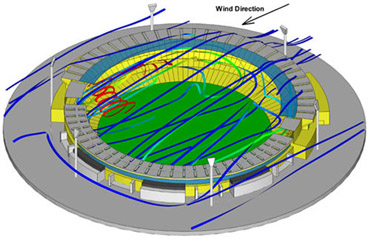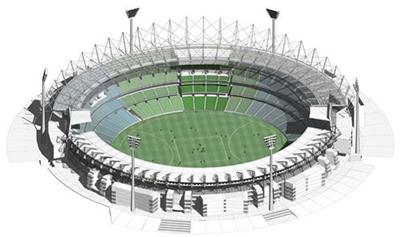Contributed by Eric Jal, Sr. Engineer, Energy Div.
Connell Wagner, Melbourne, Australia
Ventilation is a key design factor for the new Melbourne Cricket Ground (MCG). Using PHOENICS to optimize the design, CFD and Tecplot have been used to analyze air movement within the building and in external areas. In this image we see relative changes in air movement patterns across the pitch due to the construction of the new Northern Stand. When complete, the MCG will be one of the most innovative and environmentally progressive stadiums in the world.

The Melbourne Cricket Ground is Australia’s biggest and most popular stadium. It is an extremely busy venue accommodating International Cricket, Australian Rules Football, Rugby League, soccer, concerts, dinners and other major functions on its natural turf field.
The first cricket match was played at the MCG in 1854. In 1956 it was used as the main arena for the Olympic Games with 107,700 attending the opening ceremony.

The aerial view of how the MCG will look after the Northern Stand redevelopment.
In 1999 preliminary planning commenced to redevelop the northern side of the stadium (Ponsford Stand, Members Pavilion and Olympic Stand). The current conditions at the MCG prevented it from moving forward as a first-class international sporting venue – the facilities were no longer up to modern standards.
A $250 million redevelopment proposal was approved in December 2001. The Connell Mott MacDonald Arup Joint Venture was appointed as the engineering contractor for the project. Their responsibilities include all of the mechanical, electrical, civil, structural and building services engineering for the project.
A key objective of the redevelopment project is to design an environmentally sustainable MCG. Significant environmentally sustainable features for the MCG will include:
- Best practice waste recycling
- Solar electricity panels
- Solar hot water
- Roof top water collection
Ventilation is a key environmental factor in the new facility. Connell Mott MacDonald has optimized the design using PHOENICS (a computational fluid dynamics program) to model and Tecplot to visualize the air flow within and around the new stadium. Key ventilation studies have included:
- Atrium smoke modeling
- Spectator comfort conditions in the seated areas of the bowl
- General air movement patterns within the internal areas of the stand
- Dispersion of exhaust discharges from high level plant rooms
- Relative changes in air movement patterns across the pitch due to the construction of the new stand (as shown in the Tecplot image above)
A major new feature of the building is its air conditioning system. Designed to compensate for the very high ceilings of the building, it limits the spread of smoke in case of fire and enables safe evacuation.
Demolition commenced in April 2002 and the entire project should be completed by the end of 2005. In March 2006 the MCG will be the main stadium for the Commonwealth Games.
The redevelopment plan stands to transform the historic ground into Australia’s preeminent sporting facility and reaffirm its position as one of the world’s great sporting icons. It will also provide the MCG with an opportunity to showcase and display – for the very first time under one roof – the memorabilia and sporting events of the Australian Football League, cricket, Sport Australia Hall of Fame and the Olympics.





